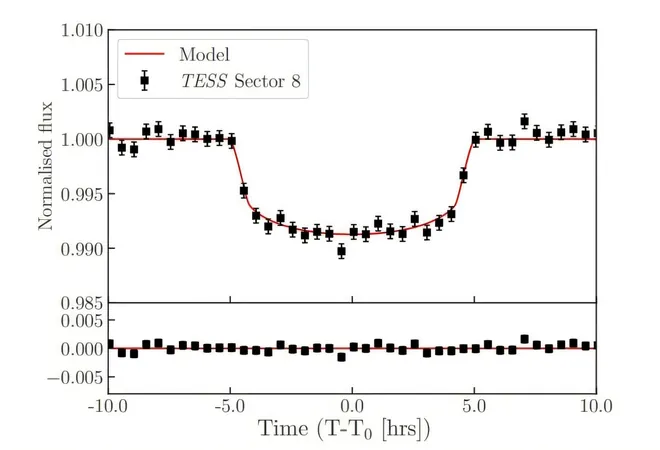
Astronomers Uncover New Eclipsing Binary System — What This Means for Stellar Evolution!
2025-01-15
Author: Rajesh
Introduction
In a groundbreaking discovery, an international team of astronomers has identified a new eclipsing binary system, designated NGTS-EB-7 AB, utilizing cutting-edge technology from the Transiting Exoplanet Survey Satellite (TESS) and the Next Generation Transit Survey (NGTS). This discovery, detailed in a recent paper published in the Monthly Notices of the Royal Astronomical Society, highlights the significance of low-mass stars — a crucial aspect of stellar studies that could reshape our understanding of the universe.
Importance of Eclipsing Binaries
Eclipsing binaries provide a unique opportunity for scientists to measure stellar parameters with unprecedented accuracy. In these systems, stars orbit closely enough that their mutual eclipses allow astronomers to determine their masses, radii, and effective temperatures directly. This is particularly relevant for M dwarfs — the faint, low-mass stars that represent the majority of the stars in our galaxy. The new findings from NGTS-EB-7 AB are poised to enhance our insights into stellar evolution and the characteristics of these elusive celestial bodies.
Details of NGTS-EB-7 AB
Led by Toby Rodel from Queen's University Belfast in the UK, the astronomers reported that NGTS-EB-7 AB is located approximately 1,500 light-years from Earth. This specific binary system consists of an evolved G-type primary star that is 45% larger and 13% more massive than our Sun, accompanied by a late M-dwarf companion. Notably, the system boasts a long orbital period of 193.36 days and a highly eccentric orbit, which contributes to its uniqueness in the known catalog of low-mass eclipsing binaries.
Characteristics of the Primary Star
The G-type primary star, designated NGTS-EB-7 A, has an effective temperature of about 5,770 K and is estimated to be around 10 billion years old. Its metallic content is also notable, with a metallicity level of 0.26 dex, indicating it is likely rich in heavier elements.
Details of the Companion Star
Meanwhile, the companion star, NGTS-EB-7 B, is approaching the limits of hydrogen burning, with a radius roughly 0.125 times that of the Sun and mass around 0.096 solar masses. This places it on the cusp of the distinction between main sequence stars and brown dwarfs.
Eccentricity and Future Observations
One of the significant aspects of the observations is the eccentricity of the M dwarf's orbit, recorded at 0.71, making it one of the most eccentric low-mass eclipsing binaries observed to date. Such high eccentricity can influence the star’s temperature and evolutionary process, allowing for additional research opportunities.
Anticipation for Future Research
Enthusiastically, the researchers anticipate that future observations, particularly by the upcoming PLATO mission, will enable the detection of the secondary eclipse of NGTS-EB-7 B. This will provide a wealth of data, further illuminating the capabilities of M dwarfs and enhancing our understanding of their properties and behavior.
Conclusion
This remarkable discovery not only enriches our astronomical catalog but also serves as a vital step toward unraveling the complexities of stellar evolution, encouraging astronomers to delve deeper into the mysteries of the universe. Stay tuned as more updates unfold about this stellar treasure!

 Brasil (PT)
Brasil (PT)
 Canada (EN)
Canada (EN)
 Chile (ES)
Chile (ES)
 Česko (CS)
Česko (CS)
 대한민국 (KO)
대한민국 (KO)
 España (ES)
España (ES)
 France (FR)
France (FR)
 Hong Kong (EN)
Hong Kong (EN)
 Italia (IT)
Italia (IT)
 日本 (JA)
日本 (JA)
 Magyarország (HU)
Magyarország (HU)
 Norge (NO)
Norge (NO)
 Polska (PL)
Polska (PL)
 Schweiz (DE)
Schweiz (DE)
 Singapore (EN)
Singapore (EN)
 Sverige (SV)
Sverige (SV)
 Suomi (FI)
Suomi (FI)
 Türkiye (TR)
Türkiye (TR)
 الإمارات العربية المتحدة (AR)
الإمارات العربية المتحدة (AR)